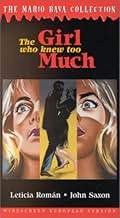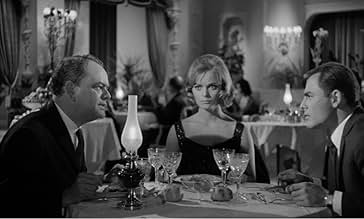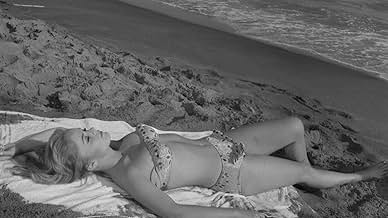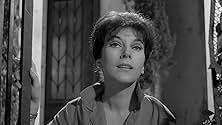VALUTAZIONE IMDb
6,9/10
6049
LA TUA VALUTAZIONE
Una turista americana appassionata di romanzi gialli assiste ad un omicidio a Roma, e presto si ritrova, col suo pretendente, coinvolta in una serie di omicidi.Una turista americana appassionata di romanzi gialli assiste ad un omicidio a Roma, e presto si ritrova, col suo pretendente, coinvolta in una serie di omicidi.Una turista americana appassionata di romanzi gialli assiste ad un omicidio a Roma, e presto si ritrova, col suo pretendente, coinvolta in una serie di omicidi.
- Regia
- Sceneggiatura
- Star
- Premi
- 1 vittoria e 1 candidatura in totale
Letícia Román
- Nora Davis
- (as Leticia Roman)
- …
Walter Williams
- Dr. Alessi
- (as Robert Buchanan)
Giovanni Di Benedetto
- Professor Torrani
- (as Gianni De Benedetto)
Dante DiPaolo
- Andrea Landini
- (as Dante Di Paolo)
Mario Bava
- Uncle Augusto
- (non citato nei titoli originali)
Geoffrey Copleston
- Asylum employee
- (non citato nei titoli originali)
Adriana Facchetti
- Woman in Sguattera Restaurant
- (non citato nei titoli originali)
Recensioni in evidenza
- Nora Davis (Leticia Roman) is a young woman hoping to have a wonderful vacation in Italy. Within 24 hours of her arrival, she is almost mistakenly arrested for drug smuggling, the aunt she is staying with dies, she has her purse stolen, and she witnesses a murder. But the police can find no body and no signs of a murder. It seems that no on believes her. It's up to Nora to discover the truth to what happened that rainy night in the plaza.
- Mario Bava is known for his magnificent use of color. So, it's a little odd that two of my favorite films that Bava made (The Girl Who Knew Too Much and Black Sunday) are black & white. Whatever the format, Bava again demonstrates his mastery of shadows and light very effectively. The film presents a series of images that are hard to forget. Each shot is perfection. One of my favorites is of the thief who steals Nora's purse as he moves from one side of the stairs to the other. It is admittedly a very minor moment, but Bava puts more care into this insignificant tracking shot than most director's do in the main scenes of their movies. It is one of the most beautiful films I've ever seen.
- The Girl Who Knew Too Much is an obvious (and not just in title) homage to Alfred Hitchcock. Bava has loaded the movie with moments that are done as I imagine Hitchcock would have done them. If the movie weren't in Italian, you would swear Hitchcock directed it.
- But the thing that make this movie so effective is Leticia Roman as Nora. Her performance is one of the best I've seen in a Bava film. She comes off as fragile, yet determined, depending upon what the script calls for. She has a believability that is necessary for this kind of movie if the audience to feel concern when she is in peril. Roman is perfect in the role.
- One final note, this movie is often cited as the first giallo. Whether this is true or not, I only know what I've read. The Girl Who Knew Too Much does establish a very elementary framework for later gialli to follow. But, it bears little resemblance to the gialli that would come later. It's not until Bava fleshed-out the giallo in Blood and Black Lace do we get look and "rules" that have become so familiar to fans of the genre.
Coming out in 1963, The Girl Who Knew Too Much is not as ground-breaking as other Mario Bava efforts but it's still every bit as stylish and suspenseful. The plot of the film, convoluted and filled with twists and red herrigns galore, anticipates the giallo cycle of the late 60's. Of course one year later the director would practically define the style with Blood and Black Lace, introducing other genre staples like the black-gloved killer, the garish colours and the gore but that doesn't detract from the ifluential status of this proto-giallo.
As the title imples, The Girl Who Knew Too Much is with one foot firmly set in Hitchcock territory, but whereas Hitch films had a tendency of trying to be too many things at once (little bits of comedy, romance etc) something I always considered distracting, Bava allows nothing to come between him and his goal: a suspenseful horror thriller.
The chiaroscuro photography is simply beautiful to look at, light and shadow play off each other in expressive ways, not unlike film-noir. Leticia Roman's face is at times only half-lit to stress her confusion, while in other set-pieces dark figures stand out against fully lit backgrounds. Bava is famous for being one of the best visual directors in the history of the medium for good reason. His black and white work is as good as his colour films.
Minor quibbles I had with the film include that many scares turn out to be false, the first person narration (another film-noir influence) and the implied possibilities in the ending *was it all a dream?* Leticia Roman and John Saxon hit it off with great chemistry, the DP work is fantabulous, the opening 15-20 minutes leading up to the first murder are among the best 20 minutes in 60's horror and this an all around accomplished horror film that deserves every fan's attention.
As the title imples, The Girl Who Knew Too Much is with one foot firmly set in Hitchcock territory, but whereas Hitch films had a tendency of trying to be too many things at once (little bits of comedy, romance etc) something I always considered distracting, Bava allows nothing to come between him and his goal: a suspenseful horror thriller.
The chiaroscuro photography is simply beautiful to look at, light and shadow play off each other in expressive ways, not unlike film-noir. Leticia Roman's face is at times only half-lit to stress her confusion, while in other set-pieces dark figures stand out against fully lit backgrounds. Bava is famous for being one of the best visual directors in the history of the medium for good reason. His black and white work is as good as his colour films.
Minor quibbles I had with the film include that many scares turn out to be false, the first person narration (another film-noir influence) and the implied possibilities in the ending *was it all a dream?* Leticia Roman and John Saxon hit it off with great chemistry, the DP work is fantabulous, the opening 15-20 minutes leading up to the first murder are among the best 20 minutes in 60's horror and this an all around accomplished horror film that deserves every fan's attention.
The movie tells how an US tourist young girl (Leticia Roman) travels to Rome and is witness a killing by a brutal killer . She's only helped by an Italian mistress (Valentina Cortese) and a good-looking young (John Saxon) , they will help resolve the series of unsolved crude assassinations carried out by the so-called Alphabet Murderer . Later on , the police wants her cooperation to seize the executioner while the mysterious series-killer soon targets her for his next victim .
In the movie there is suspense , thriller , horror and results to be very exciting . The film is entertaining for continued tension , emotion , intrigue ; besides , appearing numerous palaces , famous buildings and squares that create spectacular scenarios . The picture is considered to be the first Giallo , being rightly regarded as the seminal work in what became known as the "Giallo" genre , a sub-genre invented by Mario Bava and successfully continued by Riccardo Freda and Dario Argento . Bava would follow filming Giallos as ¨Blood and black lace¨ and classics of horror cinema as ¨Mask of demon¨ , ¨Black Sabbath¨ and ¨Planet of vampires¨ . Film casting is frankly well . Leticia Roman as an enticing scream girl is enjoyable and attractive , John Saxon as her young friend is very fine and veteran Valentina Cortese is excellent . Robert Nicolosi's musical score is atmospheric , though in the US version is composed by Les Baxter , Corman factory's regular , and the catching opening song is sung by Adriano Calentano . Magnificent white and black cinematography by the same Mario Bava , as usual in most his movies , and this was his final black and white production . At the film is shown and well photographed several monuments and squares from Rome , such as : Foro Italico Stadium , Piazza Navona , Mincio Square , Colisseum , Piazza del Popolo and Piazza di Spagna . This motion picture which in some countries was released under the following titles : "The Evil Eye" , ¨Incubus¨ or ¨Obsession diabolique¨ will appeal to terror cinema fans and Giallo enthusiasts . Rating : Good . Well worth seeing
In the movie there is suspense , thriller , horror and results to be very exciting . The film is entertaining for continued tension , emotion , intrigue ; besides , appearing numerous palaces , famous buildings and squares that create spectacular scenarios . The picture is considered to be the first Giallo , being rightly regarded as the seminal work in what became known as the "Giallo" genre , a sub-genre invented by Mario Bava and successfully continued by Riccardo Freda and Dario Argento . Bava would follow filming Giallos as ¨Blood and black lace¨ and classics of horror cinema as ¨Mask of demon¨ , ¨Black Sabbath¨ and ¨Planet of vampires¨ . Film casting is frankly well . Leticia Roman as an enticing scream girl is enjoyable and attractive , John Saxon as her young friend is very fine and veteran Valentina Cortese is excellent . Robert Nicolosi's musical score is atmospheric , though in the US version is composed by Les Baxter , Corman factory's regular , and the catching opening song is sung by Adriano Calentano . Magnificent white and black cinematography by the same Mario Bava , as usual in most his movies , and this was his final black and white production . At the film is shown and well photographed several monuments and squares from Rome , such as : Foro Italico Stadium , Piazza Navona , Mincio Square , Colisseum , Piazza del Popolo and Piazza di Spagna . This motion picture which in some countries was released under the following titles : "The Evil Eye" , ¨Incubus¨ or ¨Obsession diabolique¨ will appeal to terror cinema fans and Giallo enthusiasts . Rating : Good . Well worth seeing
La Ragazza Che Sapeva Troppo/The Girl who Knew too Much(1963) is the first of the giallo genre that didn't blossom until the late 1960s. Also the final film by Mario Bava to be done in black and white. Although a Giallo, the film follows the plot lines of the more traditional mystery story with a few twists. The film that uses the perverse and violent elements of the Gialli or Giallo is Blood & Black Lace(1964). Mario Bava's next film, Blood and Black Lace(1964) is less interested in story and more interested in mood and style. The plot involves a woman who misinterprets the meaning of a murder she witnesses. The first horror picture that John Saxon was in.
Bava in a rare instance uses naturalistic lighting. Usually the lighting in a Bava film is drenched in artful color. The only other film by Mario Bava to use naturalistic lighting is Rabid Dogs(1974). Lacks the sex and violence that dominates the gialli novels. The director was fascinated by the deception of appearences in this film and in his entire filmography. He seemed to have little optimism about human behavior or human nature. There are only three murders that occur in the film while the others happen before the story begins.
The Girl who Knew Too Much(1963) deals with Bava's favorite theme of greed. The murderer before being overcome with bloodlust does these deeds because of obsession with money. Greed is the seed of destruction for the characters in Blood & Black Lace(1964), A Bay of Blood(1971), and Rabid Dogs(1974). Part Alfred Hitchcock and part Edgar Wallace. The acting in the film is good. Leticia Roman is excellent as the naive and attractive Nora Davis. Mario Bava was not interested in doing the film but due to money reason directed it anyway.
Downplays the romantic subplot involving Nora Davis and Dr. Marcello Bassi. The scenes that uses suggestions of drug use were cut for the USA release. I love the scene where Nora sets up a booby trap to catch the murderer with disasterous results. The camera was in love with the figure of Leticia Roman during the scene at the beach while panning from her face to her feet. The short love scene between Nora and Marcello has a short spurt of eroticism. One of the writers who worked on the film was Django director, Sergio Corbucci. John Saxon does some fine acting as the leading man.
Mario Bava and John Saxon did not get along due to many misunderstandings during filming. The director it seems didn't think too highly of actors or actresses. Dante Dipaolo plays the newspaper reporter with sympathy. The use of the tape recorder by the murderer is cleaver. Valentina Cortese gets the top acting honors as the mysterious Laura Terrani. The discovery of the murderer is one of the film's main highlights. Impressed Dario Argento when he did The Bird with the Crystal Plumage(1969) and thus being responsible for the longevity and success of the Giallo in Italy.
Bava in a rare instance uses naturalistic lighting. Usually the lighting in a Bava film is drenched in artful color. The only other film by Mario Bava to use naturalistic lighting is Rabid Dogs(1974). Lacks the sex and violence that dominates the gialli novels. The director was fascinated by the deception of appearences in this film and in his entire filmography. He seemed to have little optimism about human behavior or human nature. There are only three murders that occur in the film while the others happen before the story begins.
The Girl who Knew Too Much(1963) deals with Bava's favorite theme of greed. The murderer before being overcome with bloodlust does these deeds because of obsession with money. Greed is the seed of destruction for the characters in Blood & Black Lace(1964), A Bay of Blood(1971), and Rabid Dogs(1974). Part Alfred Hitchcock and part Edgar Wallace. The acting in the film is good. Leticia Roman is excellent as the naive and attractive Nora Davis. Mario Bava was not interested in doing the film but due to money reason directed it anyway.
Downplays the romantic subplot involving Nora Davis and Dr. Marcello Bassi. The scenes that uses suggestions of drug use were cut for the USA release. I love the scene where Nora sets up a booby trap to catch the murderer with disasterous results. The camera was in love with the figure of Leticia Roman during the scene at the beach while panning from her face to her feet. The short love scene between Nora and Marcello has a short spurt of eroticism. One of the writers who worked on the film was Django director, Sergio Corbucci. John Saxon does some fine acting as the leading man.
Mario Bava and John Saxon did not get along due to many misunderstandings during filming. The director it seems didn't think too highly of actors or actresses. Dante Dipaolo plays the newspaper reporter with sympathy. The use of the tape recorder by the murderer is cleaver. Valentina Cortese gets the top acting honors as the mysterious Laura Terrani. The discovery of the murderer is one of the film's main highlights. Impressed Dario Argento when he did The Bird with the Crystal Plumage(1969) and thus being responsible for the longevity and success of the Giallo in Italy.
I saw this for the first time recently and that too the 89 mins Italian version.
This is no doubt the first giallo film and the last film Bava shot in black and white.
It is very mild when it comes to the gore n it aint scary but a bit comedic n predictable if u pay attention.
The movie plays more like a Hitchcockian thriller and it is obvious that this movie is one genius' homage to another genius.
I enjoyed this even more as i am a big fan of Saxon and his character is one of the suspect. The beach scene is hilarious.
The scene wher the priest picks up the cigarette laden with marijuana is epic.
Bava's cinematography is once again splendid.
The Piazza di Spagna n Spanish steps are captured very well.
Bava is so precise with the direction. After the murder there is rain, so one can't look for blood.
Also when the lead female is trying to recollect the murder n just when she is about to recollect the knife thrown by the killer, she is distracted by the gun shots (kid's toys) n she forgets.
P. S. In the Italian Version, Nora and Marcello are standing at an overlook, trying to forget what happened, planning their wedding. When Marcello wants to light a cigarette Nora got out of her purse, she starts thinking that it was all in her head as a result of smoking weed. She tosses the spliffs and a reverend picks them up. Now the word "FINE" appears on the screen.
In the US Version, a man with binoculars gets in a chair lift in order to shoot a woman. Nora and Marcello are in another chair lift and witness the entire thing. They are talking about getting married as well, but Marcello wishes that Nora would never ever start with any kind of crimes or murders.
This is no doubt the first giallo film and the last film Bava shot in black and white.
It is very mild when it comes to the gore n it aint scary but a bit comedic n predictable if u pay attention.
The movie plays more like a Hitchcockian thriller and it is obvious that this movie is one genius' homage to another genius.
I enjoyed this even more as i am a big fan of Saxon and his character is one of the suspect. The beach scene is hilarious.
The scene wher the priest picks up the cigarette laden with marijuana is epic.
Bava's cinematography is once again splendid.
The Piazza di Spagna n Spanish steps are captured very well.
Bava is so precise with the direction. After the murder there is rain, so one can't look for blood.
Also when the lead female is trying to recollect the murder n just when she is about to recollect the knife thrown by the killer, she is distracted by the gun shots (kid's toys) n she forgets.
P. S. In the Italian Version, Nora and Marcello are standing at an overlook, trying to forget what happened, planning their wedding. When Marcello wants to light a cigarette Nora got out of her purse, she starts thinking that it was all in her head as a result of smoking weed. She tosses the spliffs and a reverend picks them up. Now the word "FINE" appears on the screen.
In the US Version, a man with binoculars gets in a chair lift in order to shoot a woman. Nora and Marcello are in another chair lift and witness the entire thing. They are talking about getting married as well, but Marcello wishes that Nora would never ever start with any kind of crimes or murders.
Lo sapevi?
- QuizMario Bava was a big fan of Alfred Hitchcock, and Hitchcockian touches abound in the film, including a cameo by the director. In the scene where Letícia Román is in her bedroom at Ethel's home, the portrait on the wall with the eyes that keep following her is that of Mario Bava.
- BlooperWhen Nora answers the phone in the Torrani house, "hello" is heard before she speaks, even while the receiver is being lifted to her mouth.
- Citazioni
Nora Davis: [into the phone] Oh mother, murders don't just happen like that here.
- Versioni alternativeAIP released this as The Evil Eye, a recut version with material used just in some countries out of Italy.
- ConnessioniFeatured in Mario Bava: Maestro of the Macabre (2000)
- Colonne sonoreFurore
(Appears in the Italian version)
Sung by Adriano Celentano
Written and Composed by Adriano Celentano (as Adicel) and Piero Vivarelli (as Vivarelli)
Published by Edizioni Nazionalmusic and Disco Jolly
I più visti
Accedi per valutare e creare un elenco di titoli salvati per ottenere consigli personalizzati
- How long is The Evil Eye?Powered by Alexa
Dettagli
- Tempo di esecuzione
- 1h 26min(86 min)
- Colore
- Mix di suoni
- Proporzioni
- 1.66 : 1
Contribuisci a questa pagina
Suggerisci una modifica o aggiungi i contenuti mancanti

















